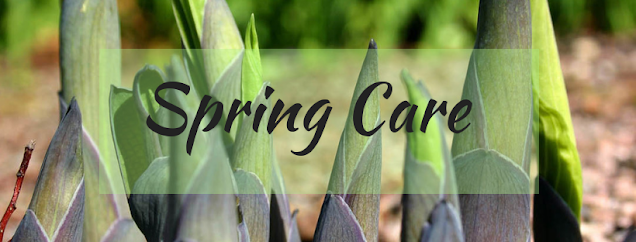Seasonal Calendar of Care for Hostas
One of the reasons that hostas continue to be so popular is the fact that they're a very low maintenance perennial.
That being said, if you follow a few basic steps to care for them, you can keep your hostas looking healthy and beautiful throughout the season, whether they're snug in the ground or in pots.
Learn what to do to care for hostas each season, including growing hostas, planting hostas, transplanting hostas, fertilizing them for maximum beauty and health.
Your Seasonal To-Do List
Water
On average, hostas require 1" of water per week, whether by rainfall or irrigation. However, do not water hostas in the Spring until the threat of frost has passed to prevent root rot. Drier is better since there are still some pretty cold days and nights ahead.

Because water is so important to good hosta health, we have installed several rain barrels at our farm. As much as I need to water during the season, I love having some free water. And if you're into being self-sufficient in as many ways as possible, a rain barrel is a great investment for the future.
Further Reading: Why You Need a RainBarrel Now
Further Reading: Why You Need a RainBarrel Now
Soil
Hostas are known for their ability to grow in just about any soil. However, rich, slightly acidic, well-draining soil will keep your hostas looking their best. An addition of compost worked into the soil can do wonders for their early growth.
Further Reading: Best Soil for Hostas
Further Reading: Best Soil for Hostas
Fertilizer
As the hostas emerge in the Spring, apply a 10-10-10 balanced fertilizer (preferably granular slow-release) around the emerging clumps. Fertilize pot-grown hostas with a diluted fertilizer (at 25% strength) every few weeks.
Protection
Don't uncover your hostas too early!
Protect ones that have already emerged from any late Spring freezes by covering them with a frost blanket, sheet, cardboard, etc. You will need to do this when the temperatures are expected to go down into the 20s.
Covering plants with plastic is not recommended as the plastic can freeze to the plant causing damage when removed.
Further Reading: Using Epsom Salt on Hostas!
Division
Division is possible now if the ground is workable. However, this is not the best time since the roots will not grow until after the leaves form.
Further Reading: When and How to Divide Hostas
Transplanting
Late Spring is a good time to transplant an entire hosta plant.
Other Care Tips for the Spring
- When all danger of frost has passed, rake the mulch that you mounded up over the hosta as winter protection away from the developing eyes to prevent crown rot.
- Apply some fresh mulch away from the center crown.
- Disinfect all hardscapes with a solution of 10% ammonia to water to kill slug eggs.
- A sprinkling of clean crushed eggshells will help deter grubs and give the hosta some added calcium.
Potted Hostas
If you've stored your potted hostas in an unheated greenhouse, garage or shed, slowly begin to acclimate the hostas to outside temperatures as it warms.
This may involve moving the potted hosta indoors and outdoors several times as the weather shifts. If the temperatures are expected to dip down in the 20s, you should cover the pot with a layer of cardboard, sheet or light blanket, etc, or better yet, bring them back inside.
Soil
Fresh soil for a new season is important. You can refresh your potting soil in the spring.
Further Reading: Refresh Your Potting Soil and Save Money
You can also replace the potting soil. I use ProMix. I have found it to be consistently good for hostas.

Water
Be careful not to water too much now. Drier is better since there are still some pretty cold days and nights ahead.
Fertilizer
As hostas emerge in Spring, apply a slow-release balanced fertilizer. Other gardeners prefer to fertilize pot-grown perennials with a diluted fertilizer (25% strength) every few weeks instead.
Water
Lack of sufficient water during a dry summer can cause the hosta to go into mid season dormancy where the outer leaves will fade and wither and the hosta will stop growing.
By keeping the hostas well watered through the summer, especially during the hottest parts, you can help to avoid the hosta looking ragged, affectionately called "The Summer Uglies" by keeping the roots moist.
Try Audible and Get Two Free Audiobooks
Increase watering so the plant receives at least 1 inch of water weekly, and cover the soil with a 2-inch mulch layer to help conserve moisture.
Because water is so important now, a soaker hose through the hosta garden is a great idea.
I use this type of soaker hose and just move it around to different areas to soak.
I use this type of soaker hose and just move it around to different areas to soak.
Hostas can tolerate periods of dryness if they are otherwise healthy. Hostas that are never stressed from lack of water will grow bigger, faster and will hold up and look nice longer into the season.
Usually, they can fend for themselves, but watering during periods of dryness will certainly help our hostas look and grow their best.
Fertilize
In early summer, give the hostas a second (and last) feeding of a balanced 10-10-10 fertilizer. Some gardeners prefer a fertilizer with a little more nitrogen at this time.
Hostas can be fertilized through the early summer, but be sure to stop two months before your expected first frost date to allow the hosta to slowly settle into its winter dormancy.
Division
It is possible to divide your hosta in the summer provided you keep the hosta divisions well watered until established.
Late summer, after the heat of the summer has passed, is the best time to divide hostas.
August is usually the perfect time and will give your hosta divisions six weeks before the first frost to establish new roots in their new home.
Other Care Tips for the Summer
Hosta blooms can vary in their timing from May to September depending on the cultivar. For a tidy appearance, you can pinch off the flower spikes after they bloom.
Water
Water every other day as needed if no rain and let soak through. This is not only to hydrate the hosta plant but will help to flush out the salts that tend to develop in potting soil.
Fertilize
Hostas generally will not need fertilizer during the summer if adequately fertilized in the spring. However, if a second fertilizing seems to be necessary, do this in early summer and then stop fertilizing for the year.
Other Care Tips for the Summer
Move the container to a shadier spot in the garden during the hottest part of the summer to reduce plant stress or use some man-made shade to give the hosta a respite from the summer's heat.
Water
As long as the hosta leaves are green, the plant will need to be watered at the base, even in the Fall.
This is because when a hosta emerges in the Spring, it is emerging on the energy and food reserves that the plant stored in its rhizome late the previous summer and Fall.
If the hosta received sufficient water in late Summer and Fall, it should emerge the next spring as a larger plant because it was able to store away more energy than it used.
However, a hosta that does not receive adequate moisture in late Summer and Fall cannot build up the energy reserves it needs to increase in size. The result is a hosta that emerges the following spring smaller than it was the year before.
Multiple unusually dry summers in a row can be especially devastating for hostas, as they are unable to replenish their depleted energy reserves.
Fertilizer
Your hostas need no further fertilizer than the Spring and early Summer. As a rule, stop fertilizing hostas two months before your expected first frost date. This will aid the hostas in preparing for their winter dormancy.
Dividing
Stop dividing any hostas six weeks before your average first frost date.
Protection
Time to prepare your hostas for their winter sleep.
Cover newly-planted hostas with an extra layer of leaves or mulch for their first winter protection. Be careful not to over mulch which can actually smother the plant.
The best mulches are leaves, straw and other biodegradable materials that are light and allow for air pockets.
Other Care Tips for Fall
Some gardeners prefer to mark the spot where the hosta will come up next spring. A small heavy rock next to each crown works well.
Since slugs produce eggs in the Fall, this is a good time to apply a slug killer.
Further Reading: Hostas and Slugs
As the greenery dies back in the Fall, you have one of two choices:
1. Leave it be. The dead foliage does provide an extra layer of mulch so many gardeners feel that removing the dead foliage is unnecessary.
2. Remove your dead foliage before the first frost and discard. (Do not compost.) This will help remove nematodes, slugs, and any diseased leaves. First, disinfect the scissors or knife you're using between cuttings with a solution of 10% bleach 90% water.
Water
Hostas in pots that are stored in an unheated space for the winter could dry out completely. Check pots once a month and add a little water if it is very dry.
The most important time to check on the soil is right after you've stored them until the hard frosts hit, and then in early Spring as it warms up.
Once it's the dead of winter, no care is needed. Do not water over frozen soil.
Protection
There are several ways to protect your hostas in pots over the winter months. The key is to keep the hostas away from direct overhead rain and to protect them from sudden swings in temperature.
There are several ways to do this:
- Move them to an unheated garage or shed.
- Bury the entire pot or group of pots in the ground or cover the group with leaves.
- Large potted hostas will normally overwinter well in place with an additional layer of mulch on top of the soil. Pots can be huddled together out of direct sun.
- After the soil is nearly frozen, you can tip the pots over on their sides to give them extra protection from overhead moisture.
- This is more labor-intensive, but if you have a prized hosta in a pot, you can plant it in the ground and repot it again the next Spring.
Side Note:
With hostas, there is no growth during dormancy as there might be with other perennials.
Water and Fertilizer
None. Don't worry about the snow -- It's a great insulator!
Protection
Hostas don't need anything during their dormancy except protection.
Hopefully you've already protected them in the Fall. If not, protect them now!
Check monthly the soil in the potted hostas that are stored in an unheated garage or shed. Only water if completely dry to the point of being dusty.
Never water frozen soil. At this time, drier is better than wetter.
~~~~~~~~~~~~~~~~~~
Hostas continue to be one of the most popular perennials on the market because of their beauty and ease of care. I hope you found the above hosta tips helpful for keeping your hostas healthy and beautiful season to season!
Winter is a great time to research next year's hosta want list
Where to go next!



















I really enjoy your site. Thank you for the great information.
ReplyDeleteThis comment has been removed by a blog administrator.
ReplyDelete